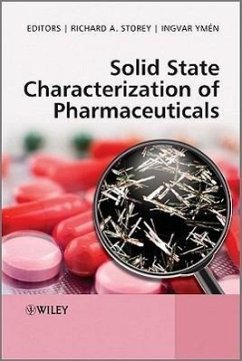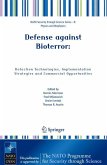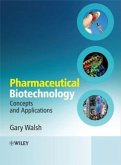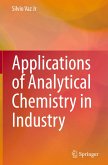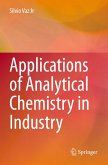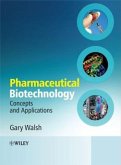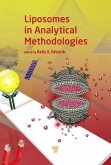Solid State Characterization of Pharmaceuticals
Herausgeber: Storey, Richard A; Ymén, Ingvar
Solid State Characterization of Pharmaceuticals
Herausgeber: Storey, Richard A; Ymén, Ingvar
- Gebundenes Buch
- Merkliste
- Auf die Merkliste
- Bewerten Bewerten
- Teilen
- Produkt teilen
- Produkterinnerung
- Produkterinnerung
The field of solid state characterization is central to the pharmaceutical industry, as drug products are, in an overwhelming number of cases, produced as solid materials. Selection of the optimum solid form is a critical aspect of the development of pharmaceutical compounds, due to their ability to exist in more than one form or crystal structure (polymorphism). These polymorphs exhibit different physical properties which can affect their biopharmaceutical properties. This book provides an up-to-date review of the current techniques used to characterize pharmaceutical solids. Ensuring…mehr
Andere Kunden interessierten sich auch für
![Defense against Bioterror: Detection Technologies, Implementation Strategies and Commercial Opportunities Defense against Bioterror: Detection Technologies, Implementation Strategies and Commercial Opportunities]() Dennis Morrison / Fred Milanovich / Dmitri Ivnitski / Thomas R. Austin (eds.)Defense against Bioterror: Detection Technologies, Implementation Strategies and Commercial Opportunities81,99 €
Dennis Morrison / Fred Milanovich / Dmitri Ivnitski / Thomas R. Austin (eds.)Defense against Bioterror: Detection Technologies, Implementation Strategies and Commercial Opportunities81,99 €![Mathematical Theory of Electrophoresis Mathematical Theory of Electrophoresis]() V. G. BabskiiMathematical Theory of Electrophoresis153,99 €
V. G. BabskiiMathematical Theory of Electrophoresis153,99 €![Pharmaceutical Biotechnology Pharmaceutical Biotechnology]() Gary WalshPharmaceutical Biotechnology110,99 €
Gary WalshPharmaceutical Biotechnology110,99 €![Applications of Analytical Chemistry in Industry Applications of Analytical Chemistry in Industry]() Silvio Vaz JrApplications of Analytical Chemistry in Industry102,99 €
Silvio Vaz JrApplications of Analytical Chemistry in Industry102,99 €![Applications of Analytical Chemistry in Industry Applications of Analytical Chemistry in Industry]() Silvio Vaz JrApplications of Analytical Chemistry in Industry77,99 €
Silvio Vaz JrApplications of Analytical Chemistry in Industry77,99 €![Pharmaceutical Biotechnology Pharmaceutical Biotechnology]() Gary WalshPharmaceutical Biotechnology234,99 €
Gary WalshPharmaceutical Biotechnology234,99 €![Liposomes in Analytical Methodologies Liposomes in Analytical Methodologies]() Liposomes in Analytical Methodologies217,99 €
Liposomes in Analytical Methodologies217,99 €-
-
-
The field of solid state characterization is central to the pharmaceutical industry, as drug products are, in an overwhelming number of cases, produced as solid materials. Selection of the optimum solid form is a critical aspect of the development of pharmaceutical compounds, due to their ability to exist in more than one form or crystal structure (polymorphism). These polymorphs exhibit different physical properties which can affect their biopharmaceutical properties. This book provides an up-to-date review of the current techniques used to characterize pharmaceutical solids. Ensuring balanced, practical coverage with industrial relevance, it covers a range of key applications in the field. The following topics are included: * Physical properties and processes * Thermodynamics * Intellectual guidance * X-ray diffraction * Spectroscopy Microscopy * Particle sizing * Mechanical properties * Vapour sorption * Thermal analysis & Calorimetry * Polymorph prediction * Form selection This book serves as a vital resource for professionals and postgraduate researchers in industrial pharmacy or pharmaceutical chemistry, drug development and analytical chemistry. It is particularly relevant for pharmaceutical scientists with limited experience of solid state characterization.
Hinweis: Dieser Artikel kann nur an eine deutsche Lieferadresse ausgeliefert werden.
Hinweis: Dieser Artikel kann nur an eine deutsche Lieferadresse ausgeliefert werden.
Produktdetails
- Produktdetails
- Verlag: Wiley
- Seitenzahl: 528
- Erscheinungstermin: 8. August 2011
- Englisch
- Abmessung: 249mm x 173mm x 33mm
- Gewicht: 1021g
- ISBN-13: 9781405134941
- ISBN-10: 1405134941
- Artikelnr.: 35351674
- Herstellerkennzeichnung
- Libri GmbH
- Europaallee 1
- 36244 Bad Hersfeld
- gpsr@libri.de
- Verlag: Wiley
- Seitenzahl: 528
- Erscheinungstermin: 8. August 2011
- Englisch
- Abmessung: 249mm x 173mm x 33mm
- Gewicht: 1021g
- ISBN-13: 9781405134941
- ISBN-10: 1405134941
- Artikelnr.: 35351674
- Herstellerkennzeichnung
- Libri GmbH
- Europaallee 1
- 36244 Bad Hersfeld
- gpsr@libri.de
Richard A. Storey, AstraZeneca Pharmaceuticals, Macclesfield, UK Ingvar Ymén, AstraZeneca R&D, Södertälje, Sweden
List of Contributors.
About the Editors.
Preface.
1. Introduction to the Solid State - Physical Properties and Processes (
Ingvar Ymen).
1.1 Introduction.
1.2 Neutral Pharmaceutical Molecules.
1.3 Thermodynamics and Phase Diagrams.
1.4 Neutral Pharmaceutical Molecules in the Solid State.
1.5 Salt Formation and Acid-Base Equilibrium.6
1.6 Polymorphs, Solvates and Mixed Crystals.
1.7 Phase Transitions and Kinetics.
1.8 Screening for 'Polymorphs' (Ansolvates and Solvates).
1.9 Summary.
1.10 Acknowledgements.
2. X-Ray Diffraction (Chris J. Gilmore).
2.1 Introduction.
2.2 Generation and Properties of X-Rays.
2.3 Crystal, Lattices, Unit Cells and Symmetry.
2.4 The Interaction of X-rays with Crystals.
2.5 Collecting Intensity Data for Single Crystals.
2.6 Determining Crystal Structures.
2.7 Powder Diffraction.
2.8 Amorphous Powders.
2.9 Particle Size.
2.10 Other Radiations: Neutrons and Electrons.
3. Spectroscopic Characterization (Andrew O'Neil and Howell Edwards).
3.1 Introduction and Theory.
3.2 Electromagnetic Radiation.
3.3 Vibrational Spectroscopy.
3.4 Mid- and Near-Infrared Spectroscopy.
3.5 Near-Infrared Spectroscopy.
3.6 Raman Spectroscopy.
3.7 Chemical Imaging and Mapping Microscopy.
3.8 Nuclear Magnetic Resonance Spectroscopy.
3.9 Terahertz Pulsed Spectroscopy.
4. Thermal Analysis - Conventional Techniques (Mark Saunders and Paul
Gabbott).
4.1 Introduction.
4.2 Differential Scanning Calorimetry (DSC).
4.3 Thermogravimetric Analysis (TGA).
4.4 Dynamic Mechanical Analysis (DMA).
4.5 Determining the Melting Behaviour of Crystalline Solids.
4.6 Polymorphism.
4.7 Solvates and Hydrates (Pseudopolymorphism).
4.8 Evolved Gas Analysis (EGA) and Simultaneous Measurements.
4.9 Amorphous Content.
4.10 Purity Determination Using DSC.
4.11 Excipient Compatibility.
5. Thermal Analysis - Dielectric Techniques (Susan Barker and Milan D.
Antonijevic).
5.1 General Introduction.
5.2 Common Background to the Techniques.
5.3 Dielectric Spectroscopy.
5.4 Thermally Stimulated Current (TSC) Spectroscopy.
5.5 Overall Conclusions.
6. Isothermal Calorimetric Analysis (Andrew Hills).
6.1 Introduction.
6.2 Calorimetry: Principle of Measurement.
6.3 Applications of IM for Characterization of Solid-State Pharmaceuticals.
6.4 Analysis of Solid-State Form Conversions.
6.5 Analysis of Solid State Chemical Reactions.
6.6 Excipient Compatibility.
7. Calorimetric Methods - Solution Calorimetry (Simon Gaisford).
7.1 Introduction.
7.2 The Principles of Solution Calorimetry.
7.3 Applications.
7.4 Summary.
8. Vapour Sorption and Surface Analysis (Jerry Y. Y. Heng and Daryl R.
Williams).
8.1 Introduction.
8.2 Inverse Gas Chromatography.
8.3 Dynamic Vapour Sorption.
9. Microscopy (Gary Nichols, Shen Luk and Clive Roberts).
9.1 Introduction.
9.2 The Microscope as an Analytical Tool.
9.3 Which Microscope to Use?
9.4 Light Microscopy.
9.5 Crystal Shape.
9.6 Particle Size.
9.7 Nonambient Light Microscopy.
9.8 Scanning Electron Microscopy.
9.9 Elemental X-Ray Microanalysis.
9.10 Atomic Force Microscopy.
9.11 Future Perspectives.
10. Particulate Analysis - Mechanical Properties (Ron J. Roberts).
10.1 Introduction.
10.2 Tableting/Comminution Process.
10.3 Indentation and Nanoindentation Testing.
10.4 Deformation Behaviour of Powders.
10.5 Evaluation of Deformation Behaviour and Compressibility.
10.6 Solubility Parameters (d) and Cohesive Energy Density (CED) and
Mechanical Properties.
10.7 Influence of Crystal Structure on Mechanical Properties.
10.8 Polymorphism and Mechanical Properties.
10.9 Hydrates/Anhydrous.
10.10 Salts.
10.11 Co-crystals.
10.12 Amorphous/Crystalline.
10.13 Conclusion.
11. Particulate Analysis - Particle Size (Xian-Ming Zeng).
11.1 Introduction.
11.2 Particle Size and Shape.
11.3 Particle Shape Analysis.
11.4 Particle Diameter.
11.5 Particle Size Distribution.
11.6 The Average Particle Size.
11.7 Particle Size Measurement.
11.8 Surface Area Measurement.
11.9 Particle Size Reduction.
11.10 Particle Size Assessment and Pharmaceutical Development.
11.11 A Case Study: Medicinal Aerosols.
11.12 Concluding Remarks.
12. Computational Polymorph Prediction (Sarah L. Price and Louise S. Price
).
12.1 Introduction.
12.3 Are Some Crystal Structures Easier to Predict than Others?
12.4 Illustrative Examples of Crystal Energy Landscapes for
Pharmaceuticals.
12.5 Property Prediction.
12.6 Future Prospects.
12.7 Acknowledgements.
13. Patenting of Inventions Relating to Polymorphs (Bertrand Gellie, Claire
Johnson and Thomas Weisbrod).
13.1 Introduction.
13.2 Clarity.
13.3 Novelty.
13.4 Inventive Step.
13.5 Sufficiency of Disclosure.
13.6 Unity of Invention.
13.7 Patenting Strategy.
14. A 'Roadmap' to Solid Form Selection (Richard Storey).
14.1 Introduction.
14.2 Summary of Solid-Form Screening Process.
14.3 Polymorph Screening.
14.4 Conclusion.
References.
Index.
About the Editors.
Preface.
1. Introduction to the Solid State - Physical Properties and Processes (
Ingvar Ymen).
1.1 Introduction.
1.2 Neutral Pharmaceutical Molecules.
1.3 Thermodynamics and Phase Diagrams.
1.4 Neutral Pharmaceutical Molecules in the Solid State.
1.5 Salt Formation and Acid-Base Equilibrium.6
1.6 Polymorphs, Solvates and Mixed Crystals.
1.7 Phase Transitions and Kinetics.
1.8 Screening for 'Polymorphs' (Ansolvates and Solvates).
1.9 Summary.
1.10 Acknowledgements.
2. X-Ray Diffraction (Chris J. Gilmore).
2.1 Introduction.
2.2 Generation and Properties of X-Rays.
2.3 Crystal, Lattices, Unit Cells and Symmetry.
2.4 The Interaction of X-rays with Crystals.
2.5 Collecting Intensity Data for Single Crystals.
2.6 Determining Crystal Structures.
2.7 Powder Diffraction.
2.8 Amorphous Powders.
2.9 Particle Size.
2.10 Other Radiations: Neutrons and Electrons.
3. Spectroscopic Characterization (Andrew O'Neil and Howell Edwards).
3.1 Introduction and Theory.
3.2 Electromagnetic Radiation.
3.3 Vibrational Spectroscopy.
3.4 Mid- and Near-Infrared Spectroscopy.
3.5 Near-Infrared Spectroscopy.
3.6 Raman Spectroscopy.
3.7 Chemical Imaging and Mapping Microscopy.
3.8 Nuclear Magnetic Resonance Spectroscopy.
3.9 Terahertz Pulsed Spectroscopy.
4. Thermal Analysis - Conventional Techniques (Mark Saunders and Paul
Gabbott).
4.1 Introduction.
4.2 Differential Scanning Calorimetry (DSC).
4.3 Thermogravimetric Analysis (TGA).
4.4 Dynamic Mechanical Analysis (DMA).
4.5 Determining the Melting Behaviour of Crystalline Solids.
4.6 Polymorphism.
4.7 Solvates and Hydrates (Pseudopolymorphism).
4.8 Evolved Gas Analysis (EGA) and Simultaneous Measurements.
4.9 Amorphous Content.
4.10 Purity Determination Using DSC.
4.11 Excipient Compatibility.
5. Thermal Analysis - Dielectric Techniques (Susan Barker and Milan D.
Antonijevic).
5.1 General Introduction.
5.2 Common Background to the Techniques.
5.3 Dielectric Spectroscopy.
5.4 Thermally Stimulated Current (TSC) Spectroscopy.
5.5 Overall Conclusions.
6. Isothermal Calorimetric Analysis (Andrew Hills).
6.1 Introduction.
6.2 Calorimetry: Principle of Measurement.
6.3 Applications of IM for Characterization of Solid-State Pharmaceuticals.
6.4 Analysis of Solid-State Form Conversions.
6.5 Analysis of Solid State Chemical Reactions.
6.6 Excipient Compatibility.
7. Calorimetric Methods - Solution Calorimetry (Simon Gaisford).
7.1 Introduction.
7.2 The Principles of Solution Calorimetry.
7.3 Applications.
7.4 Summary.
8. Vapour Sorption and Surface Analysis (Jerry Y. Y. Heng and Daryl R.
Williams).
8.1 Introduction.
8.2 Inverse Gas Chromatography.
8.3 Dynamic Vapour Sorption.
9. Microscopy (Gary Nichols, Shen Luk and Clive Roberts).
9.1 Introduction.
9.2 The Microscope as an Analytical Tool.
9.3 Which Microscope to Use?
9.4 Light Microscopy.
9.5 Crystal Shape.
9.6 Particle Size.
9.7 Nonambient Light Microscopy.
9.8 Scanning Electron Microscopy.
9.9 Elemental X-Ray Microanalysis.
9.10 Atomic Force Microscopy.
9.11 Future Perspectives.
10. Particulate Analysis - Mechanical Properties (Ron J. Roberts).
10.1 Introduction.
10.2 Tableting/Comminution Process.
10.3 Indentation and Nanoindentation Testing.
10.4 Deformation Behaviour of Powders.
10.5 Evaluation of Deformation Behaviour and Compressibility.
10.6 Solubility Parameters (d) and Cohesive Energy Density (CED) and
Mechanical Properties.
10.7 Influence of Crystal Structure on Mechanical Properties.
10.8 Polymorphism and Mechanical Properties.
10.9 Hydrates/Anhydrous.
10.10 Salts.
10.11 Co-crystals.
10.12 Amorphous/Crystalline.
10.13 Conclusion.
11. Particulate Analysis - Particle Size (Xian-Ming Zeng).
11.1 Introduction.
11.2 Particle Size and Shape.
11.3 Particle Shape Analysis.
11.4 Particle Diameter.
11.5 Particle Size Distribution.
11.6 The Average Particle Size.
11.7 Particle Size Measurement.
11.8 Surface Area Measurement.
11.9 Particle Size Reduction.
11.10 Particle Size Assessment and Pharmaceutical Development.
11.11 A Case Study: Medicinal Aerosols.
11.12 Concluding Remarks.
12. Computational Polymorph Prediction (Sarah L. Price and Louise S. Price
).
12.1 Introduction.
12.3 Are Some Crystal Structures Easier to Predict than Others?
12.4 Illustrative Examples of Crystal Energy Landscapes for
Pharmaceuticals.
12.5 Property Prediction.
12.6 Future Prospects.
12.7 Acknowledgements.
13. Patenting of Inventions Relating to Polymorphs (Bertrand Gellie, Claire
Johnson and Thomas Weisbrod).
13.1 Introduction.
13.2 Clarity.
13.3 Novelty.
13.4 Inventive Step.
13.5 Sufficiency of Disclosure.
13.6 Unity of Invention.
13.7 Patenting Strategy.
14. A 'Roadmap' to Solid Form Selection (Richard Storey).
14.1 Introduction.
14.2 Summary of Solid-Form Screening Process.
14.3 Polymorph Screening.
14.4 Conclusion.
References.
Index.
List of Contributors.
About the Editors.
Preface.
1. Introduction to the Solid State - Physical Properties and Processes (
Ingvar Ymen).
1.1 Introduction.
1.2 Neutral Pharmaceutical Molecules.
1.3 Thermodynamics and Phase Diagrams.
1.4 Neutral Pharmaceutical Molecules in the Solid State.
1.5 Salt Formation and Acid-Base Equilibrium.6
1.6 Polymorphs, Solvates and Mixed Crystals.
1.7 Phase Transitions and Kinetics.
1.8 Screening for 'Polymorphs' (Ansolvates and Solvates).
1.9 Summary.
1.10 Acknowledgements.
2. X-Ray Diffraction (Chris J. Gilmore).
2.1 Introduction.
2.2 Generation and Properties of X-Rays.
2.3 Crystal, Lattices, Unit Cells and Symmetry.
2.4 The Interaction of X-rays with Crystals.
2.5 Collecting Intensity Data for Single Crystals.
2.6 Determining Crystal Structures.
2.7 Powder Diffraction.
2.8 Amorphous Powders.
2.9 Particle Size.
2.10 Other Radiations: Neutrons and Electrons.
3. Spectroscopic Characterization (Andrew O'Neil and Howell Edwards).
3.1 Introduction and Theory.
3.2 Electromagnetic Radiation.
3.3 Vibrational Spectroscopy.
3.4 Mid- and Near-Infrared Spectroscopy.
3.5 Near-Infrared Spectroscopy.
3.6 Raman Spectroscopy.
3.7 Chemical Imaging and Mapping Microscopy.
3.8 Nuclear Magnetic Resonance Spectroscopy.
3.9 Terahertz Pulsed Spectroscopy.
4. Thermal Analysis - Conventional Techniques (Mark Saunders and Paul
Gabbott).
4.1 Introduction.
4.2 Differential Scanning Calorimetry (DSC).
4.3 Thermogravimetric Analysis (TGA).
4.4 Dynamic Mechanical Analysis (DMA).
4.5 Determining the Melting Behaviour of Crystalline Solids.
4.6 Polymorphism.
4.7 Solvates and Hydrates (Pseudopolymorphism).
4.8 Evolved Gas Analysis (EGA) and Simultaneous Measurements.
4.9 Amorphous Content.
4.10 Purity Determination Using DSC.
4.11 Excipient Compatibility.
5. Thermal Analysis - Dielectric Techniques (Susan Barker and Milan D.
Antonijevic).
5.1 General Introduction.
5.2 Common Background to the Techniques.
5.3 Dielectric Spectroscopy.
5.4 Thermally Stimulated Current (TSC) Spectroscopy.
5.5 Overall Conclusions.
6. Isothermal Calorimetric Analysis (Andrew Hills).
6.1 Introduction.
6.2 Calorimetry: Principle of Measurement.
6.3 Applications of IM for Characterization of Solid-State Pharmaceuticals.
6.4 Analysis of Solid-State Form Conversions.
6.5 Analysis of Solid State Chemical Reactions.
6.6 Excipient Compatibility.
7. Calorimetric Methods - Solution Calorimetry (Simon Gaisford).
7.1 Introduction.
7.2 The Principles of Solution Calorimetry.
7.3 Applications.
7.4 Summary.
8. Vapour Sorption and Surface Analysis (Jerry Y. Y. Heng and Daryl R.
Williams).
8.1 Introduction.
8.2 Inverse Gas Chromatography.
8.3 Dynamic Vapour Sorption.
9. Microscopy (Gary Nichols, Shen Luk and Clive Roberts).
9.1 Introduction.
9.2 The Microscope as an Analytical Tool.
9.3 Which Microscope to Use?
9.4 Light Microscopy.
9.5 Crystal Shape.
9.6 Particle Size.
9.7 Nonambient Light Microscopy.
9.8 Scanning Electron Microscopy.
9.9 Elemental X-Ray Microanalysis.
9.10 Atomic Force Microscopy.
9.11 Future Perspectives.
10. Particulate Analysis - Mechanical Properties (Ron J. Roberts).
10.1 Introduction.
10.2 Tableting/Comminution Process.
10.3 Indentation and Nanoindentation Testing.
10.4 Deformation Behaviour of Powders.
10.5 Evaluation of Deformation Behaviour and Compressibility.
10.6 Solubility Parameters (d) and Cohesive Energy Density (CED) and
Mechanical Properties.
10.7 Influence of Crystal Structure on Mechanical Properties.
10.8 Polymorphism and Mechanical Properties.
10.9 Hydrates/Anhydrous.
10.10 Salts.
10.11 Co-crystals.
10.12 Amorphous/Crystalline.
10.13 Conclusion.
11. Particulate Analysis - Particle Size (Xian-Ming Zeng).
11.1 Introduction.
11.2 Particle Size and Shape.
11.3 Particle Shape Analysis.
11.4 Particle Diameter.
11.5 Particle Size Distribution.
11.6 The Average Particle Size.
11.7 Particle Size Measurement.
11.8 Surface Area Measurement.
11.9 Particle Size Reduction.
11.10 Particle Size Assessment and Pharmaceutical Development.
11.11 A Case Study: Medicinal Aerosols.
11.12 Concluding Remarks.
12. Computational Polymorph Prediction (Sarah L. Price and Louise S. Price
).
12.1 Introduction.
12.3 Are Some Crystal Structures Easier to Predict than Others?
12.4 Illustrative Examples of Crystal Energy Landscapes for
Pharmaceuticals.
12.5 Property Prediction.
12.6 Future Prospects.
12.7 Acknowledgements.
13. Patenting of Inventions Relating to Polymorphs (Bertrand Gellie, Claire
Johnson and Thomas Weisbrod).
13.1 Introduction.
13.2 Clarity.
13.3 Novelty.
13.4 Inventive Step.
13.5 Sufficiency of Disclosure.
13.6 Unity of Invention.
13.7 Patenting Strategy.
14. A 'Roadmap' to Solid Form Selection (Richard Storey).
14.1 Introduction.
14.2 Summary of Solid-Form Screening Process.
14.3 Polymorph Screening.
14.4 Conclusion.
References.
Index.
About the Editors.
Preface.
1. Introduction to the Solid State - Physical Properties and Processes (
Ingvar Ymen).
1.1 Introduction.
1.2 Neutral Pharmaceutical Molecules.
1.3 Thermodynamics and Phase Diagrams.
1.4 Neutral Pharmaceutical Molecules in the Solid State.
1.5 Salt Formation and Acid-Base Equilibrium.6
1.6 Polymorphs, Solvates and Mixed Crystals.
1.7 Phase Transitions and Kinetics.
1.8 Screening for 'Polymorphs' (Ansolvates and Solvates).
1.9 Summary.
1.10 Acknowledgements.
2. X-Ray Diffraction (Chris J. Gilmore).
2.1 Introduction.
2.2 Generation and Properties of X-Rays.
2.3 Crystal, Lattices, Unit Cells and Symmetry.
2.4 The Interaction of X-rays with Crystals.
2.5 Collecting Intensity Data for Single Crystals.
2.6 Determining Crystal Structures.
2.7 Powder Diffraction.
2.8 Amorphous Powders.
2.9 Particle Size.
2.10 Other Radiations: Neutrons and Electrons.
3. Spectroscopic Characterization (Andrew O'Neil and Howell Edwards).
3.1 Introduction and Theory.
3.2 Electromagnetic Radiation.
3.3 Vibrational Spectroscopy.
3.4 Mid- and Near-Infrared Spectroscopy.
3.5 Near-Infrared Spectroscopy.
3.6 Raman Spectroscopy.
3.7 Chemical Imaging and Mapping Microscopy.
3.8 Nuclear Magnetic Resonance Spectroscopy.
3.9 Terahertz Pulsed Spectroscopy.
4. Thermal Analysis - Conventional Techniques (Mark Saunders and Paul
Gabbott).
4.1 Introduction.
4.2 Differential Scanning Calorimetry (DSC).
4.3 Thermogravimetric Analysis (TGA).
4.4 Dynamic Mechanical Analysis (DMA).
4.5 Determining the Melting Behaviour of Crystalline Solids.
4.6 Polymorphism.
4.7 Solvates and Hydrates (Pseudopolymorphism).
4.8 Evolved Gas Analysis (EGA) and Simultaneous Measurements.
4.9 Amorphous Content.
4.10 Purity Determination Using DSC.
4.11 Excipient Compatibility.
5. Thermal Analysis - Dielectric Techniques (Susan Barker and Milan D.
Antonijevic).
5.1 General Introduction.
5.2 Common Background to the Techniques.
5.3 Dielectric Spectroscopy.
5.4 Thermally Stimulated Current (TSC) Spectroscopy.
5.5 Overall Conclusions.
6. Isothermal Calorimetric Analysis (Andrew Hills).
6.1 Introduction.
6.2 Calorimetry: Principle of Measurement.
6.3 Applications of IM for Characterization of Solid-State Pharmaceuticals.
6.4 Analysis of Solid-State Form Conversions.
6.5 Analysis of Solid State Chemical Reactions.
6.6 Excipient Compatibility.
7. Calorimetric Methods - Solution Calorimetry (Simon Gaisford).
7.1 Introduction.
7.2 The Principles of Solution Calorimetry.
7.3 Applications.
7.4 Summary.
8. Vapour Sorption and Surface Analysis (Jerry Y. Y. Heng and Daryl R.
Williams).
8.1 Introduction.
8.2 Inverse Gas Chromatography.
8.3 Dynamic Vapour Sorption.
9. Microscopy (Gary Nichols, Shen Luk and Clive Roberts).
9.1 Introduction.
9.2 The Microscope as an Analytical Tool.
9.3 Which Microscope to Use?
9.4 Light Microscopy.
9.5 Crystal Shape.
9.6 Particle Size.
9.7 Nonambient Light Microscopy.
9.8 Scanning Electron Microscopy.
9.9 Elemental X-Ray Microanalysis.
9.10 Atomic Force Microscopy.
9.11 Future Perspectives.
10. Particulate Analysis - Mechanical Properties (Ron J. Roberts).
10.1 Introduction.
10.2 Tableting/Comminution Process.
10.3 Indentation and Nanoindentation Testing.
10.4 Deformation Behaviour of Powders.
10.5 Evaluation of Deformation Behaviour and Compressibility.
10.6 Solubility Parameters (d) and Cohesive Energy Density (CED) and
Mechanical Properties.
10.7 Influence of Crystal Structure on Mechanical Properties.
10.8 Polymorphism and Mechanical Properties.
10.9 Hydrates/Anhydrous.
10.10 Salts.
10.11 Co-crystals.
10.12 Amorphous/Crystalline.
10.13 Conclusion.
11. Particulate Analysis - Particle Size (Xian-Ming Zeng).
11.1 Introduction.
11.2 Particle Size and Shape.
11.3 Particle Shape Analysis.
11.4 Particle Diameter.
11.5 Particle Size Distribution.
11.6 The Average Particle Size.
11.7 Particle Size Measurement.
11.8 Surface Area Measurement.
11.9 Particle Size Reduction.
11.10 Particle Size Assessment and Pharmaceutical Development.
11.11 A Case Study: Medicinal Aerosols.
11.12 Concluding Remarks.
12. Computational Polymorph Prediction (Sarah L. Price and Louise S. Price
).
12.1 Introduction.
12.3 Are Some Crystal Structures Easier to Predict than Others?
12.4 Illustrative Examples of Crystal Energy Landscapes for
Pharmaceuticals.
12.5 Property Prediction.
12.6 Future Prospects.
12.7 Acknowledgements.
13. Patenting of Inventions Relating to Polymorphs (Bertrand Gellie, Claire
Johnson and Thomas Weisbrod).
13.1 Introduction.
13.2 Clarity.
13.3 Novelty.
13.4 Inventive Step.
13.5 Sufficiency of Disclosure.
13.6 Unity of Invention.
13.7 Patenting Strategy.
14. A 'Roadmap' to Solid Form Selection (Richard Storey).
14.1 Introduction.
14.2 Summary of Solid-Form Screening Process.
14.3 Polymorph Screening.
14.4 Conclusion.
References.
Index.

